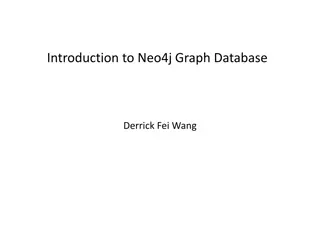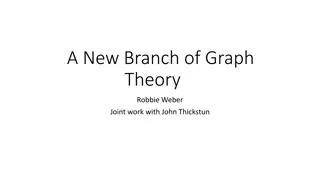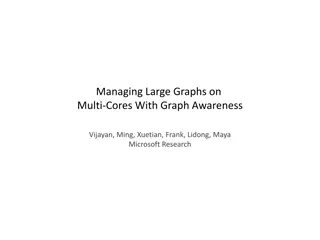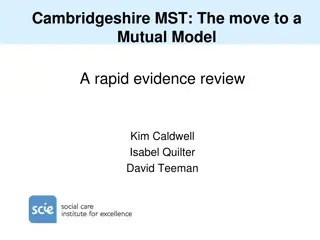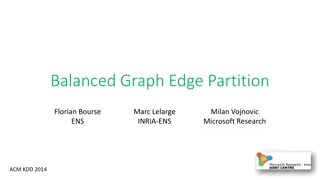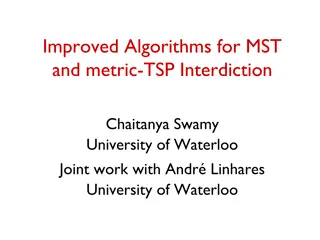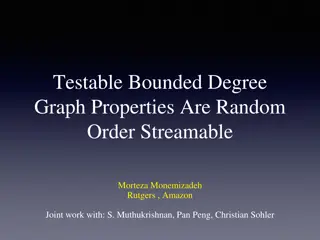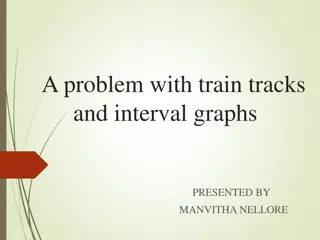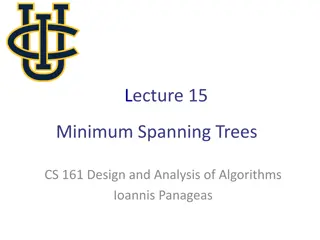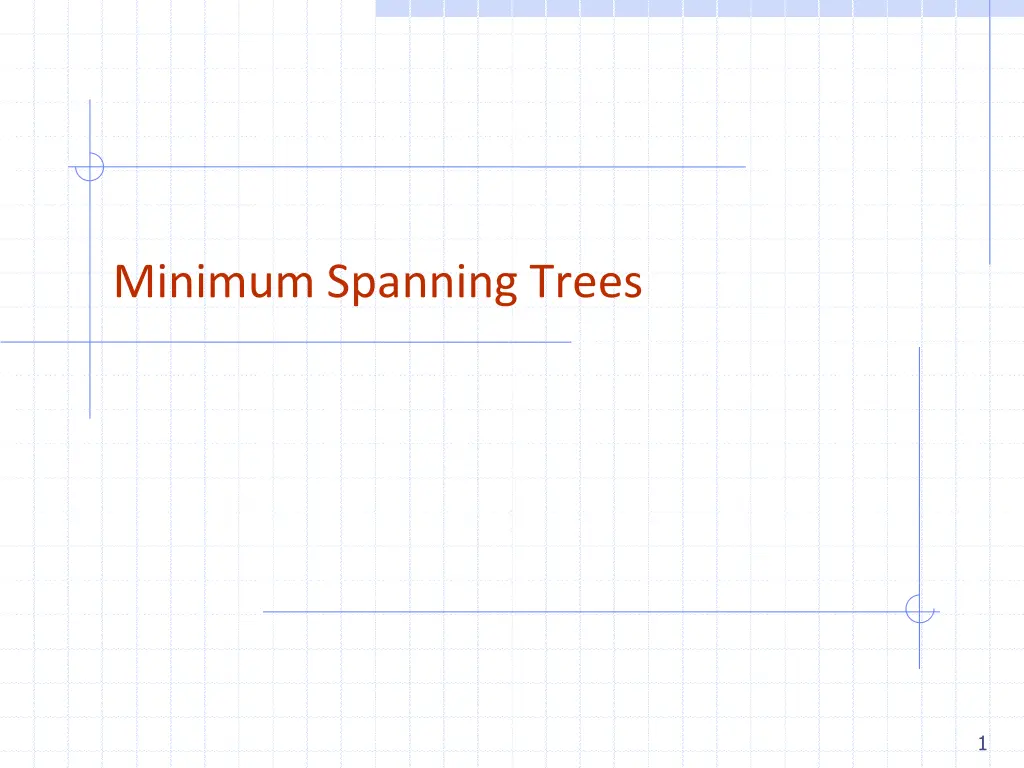
Understanding Minimum Spanning Trees and Kruskal's Algorithm
Delve into the concepts of minimum spanning trees, their properties like cycle and partition, and the application of Kruskal's Algorithm for finding the minimum spanning tree in a weighted graph. Explore examples and insights into maintaining vertex clusters during the algorithm.
Download Presentation

Please find below an Image/Link to download the presentation.
The content on the website is provided AS IS for your information and personal use only. It may not be sold, licensed, or shared on other websites without obtaining consent from the author. If you encounter any issues during the download, it is possible that the publisher has removed the file from their server.
You are allowed to download the files provided on this website for personal or commercial use, subject to the condition that they are used lawfully. All files are the property of their respective owners.
The content on the website is provided AS IS for your information and personal use only. It may not be sold, licensed, or shared on other websites without obtaining consent from the author.
E N D
Presentation Transcript
Minimum Spanning Trees Spanning subgraph Subgraph of a graph G containing all the vertices of G Spanning tree ORD 10 1 PIT Spanning subgraph that is itself a (free) tree Minimum spanning tree (MST) DEN 6 7 9 Spanning tree of a weighted graph with minimum total edge weight Applications 3 DCA STL 4 5 8 2 Communications networks Transportation networks DFW ATL 2
Cycle Property Cycle Property: Let T be a minimum spanning tree of a weighted graph G Let e be an edge of G that is not in T and C let be the cycle formed by e with T For every edge f of C,weight(f) weight(e) Proof: 8 f 4 C 9 6 2 3 e 7 8 7 Replacing f with e yields a better spanning tree By contradiction If weight(f) weight(e) we can get a spanning tree of smaller weight by replacing e with f 8 f 4 C 9 6 2 3 e 7 8 7 3
Partition Property U V Partition Property: 7 f Consider a partition of the vertices of G into subsets U and V Let e be an edge of minimum weight across the partition 4 9 5 2 8 3 8 e There is a minimum spanning tree of G containing edge e Proof: Let T be an MST of G If T does not contain e, consider the cycle C formed by e with T and let f be an edge of C across the partition 7 Replacing f with e yields another MST U V 7 f 4 9 By the cycle property, Thus, weight(f)= = weight(e) 5 2 weight(f) weight(e) 8 3 8 e We obtain another MST by replacing f with e 7 4
Kruskals Algorithm: Example G G 8 8 B B 4 4 E E 9 9 6 6 5 5 F F 1 1 3 C 3 C 11 11 2 2 H 7 H 7 D D A A 10 10 G G 8 8 B B 4 4 E E 9 9 6 6 5 5 F F 1 1 3 3 C C 11 11 2 2 H H 7 7 D D A A 10 10 6
Example (contd.) G G 8 8 B B 4 4 E E 9 9 6 6 5 5 F F 1 1 3 C 3 C 11 11 2 2 H 7 H 7 D D A A 10 10 four steps G G 8 8 B B 4 4 E E 9 9 6 6 5 5 F F 1 1 3 3 C C 11 11 2 2 H H 7 7 D D A A 10 10 7
Kruskals Algorithm Maintain a partition of the vertices into clusters AlgorithmKruskalMST(G) for each vertex v in Gdo Create a cluster consisting of v letQbe a priority queue. Insert all edges into Q T {T is the union of the MSTs of the clusters} whileT has fewer than n 1 edges do e Q.removeMin().getValue() [u, v] G.endVertices(e) A getCluster(u) B getCluster(v) ifA Bthen Add edge e to T mergeClusters(A, B) return T Initially, single-vertex clusters Keep an MST for each cluster Merge closest clusters and their MSTs A priority queue stores the edges outside clusters Key: weight Element: edge At the end of the algorithm One cluster and one MST (if connected) 8
Data Structure for Kruskals Algorithm The algorithm maintains a forest of trees A priority queue extracts the edges by increasing weight An edge is accepted it if connects distinct trees We need a data structure that maintains a partition, i.e., a collection of disjoint sets To do this, we need a data structure for a set These are covered in Ch. 11.4 (Page 533) 9
Set Operations We represent a set by the sorted sequence of its elements The basic set operations: union intersection subtraction We consider Sequence-based implementation 10
Example: Storing a Set in a Sorted List We can implement a set with a list Elements are stored sorted according to some canonical ordering The space used is O(n) Nodes storing set elements in order List Set elements 11
Partitions with Union-Find Operations Partition: A collection of disjoint sets Partition ADT needs to support the following functions: makeSet(x): Create a singleton set containing the element x and return the position storing x in this set union(A,B): Return the set A U B, destroying the old A and B find(p): Return the set containing the element at position p 12
List-based Partition (1) Each set is stored in a sequence (e.g., list) Partition: A collection of sequences Each element has a reference back to the set Operation find(u): takes O(1) time, and returns the set of which u is a member. Operation union(A,B): we move the elements of the smaller set to the sequence of the larger set and update their references Time for operation union(A,B) is min(|A|, |B|) Worst-case: O(n) for one union operation 13
List-based Partition (2) What about amortized analysis ? (Page 539) Clearly, makeSet and find operation O(n) Union operation Each time we move a position from one set to another, the size of the new set at least doubles Thus, each position is moved from one set to another at most log n times We assume that the partition is initially empty, there are O(n) different elements referenced in the given series of operations. The total time for all the union operations is O(n log n) 14
Partition-Based Implementation Partition-based version of Kruskal s Algorithm AlgorithmKruskalMST(G) Initialize a partition P for each vertex v in Gdo P.makeSet(v) letQbe a priority queue. Insert all edges into Q T {T is the union of the MSTs of the clusters} whileT has fewer than n 1 edges do e Q.removeMin().getValue() [u, v] G.endVertices(e) A P.find(u) B P.find(v) ifA Bthen Add edge e to T P.union(A, B) return T Cluster merges as unions Cluster locations as finds Running time O((n + m) log n) PQ operations O(m log n) PQ initialization: O(mlog m) For each while loop O(log m) = O(log n) UF operations O(n log n) 15
Example 7 D D 7 7 2 2 B B 4 4 9 9 8 5 5 5 F F 2 2 C C 8 8 3 3 8 8 E E A A 7 7 7 7 0 0 7 7 D 7 D 2 7 2 B 4 B 4 9 5 4 9 5 5 F 2 5 F C 2 C 8 8 3 3 8 8 E E A 7 A 7 7 0 7 0 17
Example (contd.) 7 D 7 2 B 4 4 9 5 5 F 2 C 8 3 8 E A 3 7 7 0 D 7 2 B 4 4 9 5 5 F 2 C 8 3 8 E A 3 7 0 18
Prim-Jarniks Algorithm Similar to Dijkstra s algorithm We pick an arbitrary vertex s and we grow the MST as a cloud of vertices, starting from s We store with each vertex v label d(v) representing the smallest weight of an edge connecting v to a vertex in the cloud (see the difference from Dijkstra s algorithm?) At each step: We add to the cloud the vertex u outside the cloud with the smallest distance label We update the labels of the vertices adjacent to u 19
Prim-Jarniks Algorithm (cont.) A heap-based adaptable priority queue with location- aware entries stores the vertices outside the cloud AlgorithmPrimJarnikMST(G) Q new heap-based priority queue s a vertex of G for all v G.vertices() ifv= s v.setDistance(0) else v.setDistance( ) v.setParent( ) l Q.insert(v.getDistance(),v) v.setLocator(l) while Q.empty() l Q.removeMin() u l.getValue() for all e u.incidentEdges() z e.opposite(u) r e.weight() ifr z.getDistance() z.setDistance(r) z.setParent(e) Q.replaceKey(z.getEntry(), r) Key: distance Value: vertex Recall that method replaceKey(l,k) changes the key of entry l We store three labels with each vertex: Distance Parent edge in MST Entry in priority queue 20
Analysis Graph operations Method incidentEdges is called once for each vertex Label operations We set/get the distance, parent and locator labels of vertex zO(deg(z)) times Setting/getting a label takes O(1) time Priority queue operations Each vertex is inserted once into and removed once from the priority queue, where each insertion or removal takes O(log n) time (total n O(log n)) The key of a vertex w in the priority queue is modified at most deg(w) times, where each key change takes O(log n) time Prim-Jarnik s algorithm runs in O((n + m) log n) time provided the graph is represented by the adjacency list structure Recall that v deg(v)= 2m The running time is O(m log n) since the graph is connected 21




